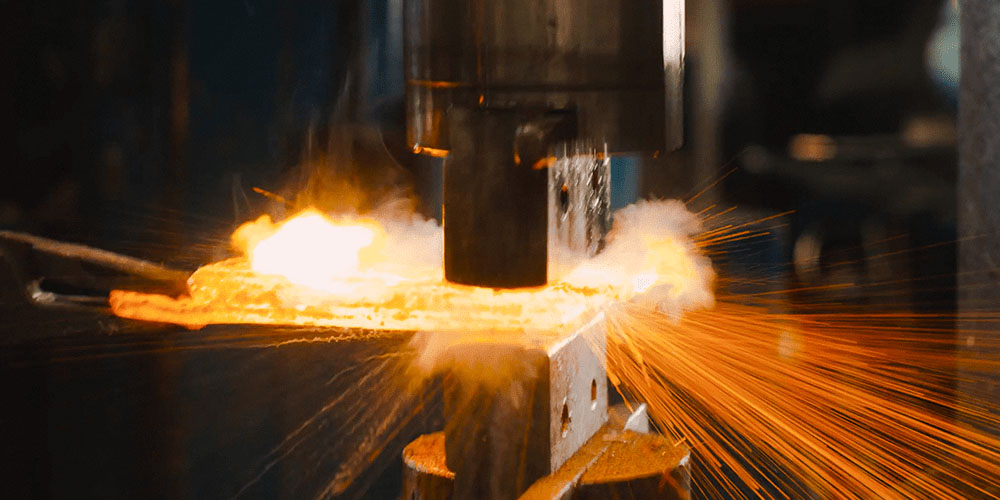A form of forging technology known as “hot die forging” often describes a precise forging technique in which the metal blank is heated before forging. The metal blank is plastically shaped into the shape and size of the forging after being heated to a temperature greater than the material’s recrystallization temperature.
The most popular forging method is hot forging. In the hot forging process, forging is done at a temperature higher than the metal’s recrystallization temperature, or the temperature at which new grains start to form in the metal. In order to prevent strain hardening of the metal during deformation, this kind of intense heat is required.
Cxin Forging is a reputable hot forging manufacturer with significant forging knowledge, including hot forging, warm forging, and cold forging, in addition to design and technical knowledge. With their unmatched production skills, they work hard to challenge long-standing conventions and consistently outperform them.
Positive Aspects of Hot Forging
- High strain rates result in smooth metal flow.
- Recovery and recrystallization are possibilities.
- Less force is required.
Negative Aspects of Hot Forging
- It is challenging to lubricate at high temperatures.
- On the workpiece, oxidation, and scaling take place.
- It has bad surface quality.
- It has tolerances that are less exact.
- It’s possible that the material will bend when it cools.
Applications of Hot Forging
Elevated temperatures and improved formability enable recrystallization, which allows for precise control of microstructure with a very fine grain. Forging qualifies as a manufacturing method in all situations when operating with heavy loads, both static and dynamic place unique demands on the component because strength-durability combinations can be set more precisely than in any other forming process.
Automotive Forgings
The majority of steel forging uses are in the automotive industry. Due to the rising demand for lightweight construction, the use of wrought aluminum alloys is growing popular; magnesium is rarely used.
Components in the volume sector are forged using a closed die forging technique is generally small to medium series. This makes it possible to use the majority of strong and effective autonomous components. Below is a list of common automobile forgings. Both passenger automobiles and business trucks can use the following examples:
- Engine Parts: Pistons, connecting rods, distributor housings, crankshafts, cams, camshafts, and balancing shafts are among the engine parts.
- Driving Gear: Various pinion types, synchronizer rings, CVTs, and other driving gear
- Powertrain: Drivetrain components include drive shafts, universal joints, wheel hubs, and joint discs.
- Undercarriage: Wheel carriers for the undercarriage, bearings on the pivot, axle journal, ball stubs, axle stubs, wishbones, front axle beams, and steering controls, other components make up the undercarriage.
- Brake system: brake handles, brake cylinders, and carriers, and brake plates
Aerospace Applications
In the aerospace industry, specific materials with high strength and temperature resistance, such as lightweight, titanium, and nickel-based alloys building materials like magnesium and wrought aluminum alloys, are employed in addition to steel forgings.
- Components of the fuselage, such as the ribs, window frames, and door and wing fittings.
- Engine with discs, thrust cones, turbine blades, and control levers.
- Empennage fittings with guiding rails.
- Landing gear: pins, fasteners, and carriers.
- Systems for rotors: fixtures, rotor heads, and gearbox covers.
Miscellaneous Applications
Applications for hot forging go beyond the industries of transportation and aircraft. Additionally, there are some other significant application areas where hot forgings might demonstrate their advantages:
- Building construction Mechanical engineering.
- Agriculture industry defense.
- Construction in Steel Offshore Industry.
- Sanitary industry.
- The watchmaking and precision engineering industries.
Last Words
Above a metal’s recrystallization temperature is where hot forging takes place. To distinguish it from the cold forging procedure, utilize the homologous temperature (TH) (see Hot forging vs. Cold forging). Summarizing the appropriate forging temperature range is essential for hot forging process practice. Using the forging resistance to deformation principle, create superior control measures for the plastic deformation scheme. This guarantees that the forging’s powerful oxidation characteristics may be produced.

